Can Wicker Furniture Get Wet? Ultimate Guide to Protecting Your Wicker from Water Damage
Wicker furniture, with its charming aesthetic and comfortable appeal, is a popular choice for both indoor and outdoor spaces. But a common question often arises among owners and prospective buyers: “Can wicker furniture get wet?” The short answer is yes, it can, but the long answer involves understanding the nuances between different types of wicker and how water affects them. Without proper care and protection, exposure to moisture can significantly diminish the lifespan and beauty of your beloved wicker pieces.
This comprehensive guide aims to demystify the interaction between wicker furniture and water. We’ll delve into what wicker truly is, differentiate between natural and synthetic variations, explain the specific damages water can inflict, and, most importantly, provide actionable strategies to protect your investment from rain, snow, and humidity. By following these expert tips, you can enjoy your wicker furniture for many years to come and avoid costly repairs or replacements.
Understanding Wicker Furniture: More Than Just a Material
Before we dive into the specifics of water damage, it’s crucial to understand what wicker actually is. Contrary to popular belief, “wicker” isn’t a material itself; rather, it’s an ancient weaving technique. This method involves twisting, bending, and interweaving thin strands of various materials into intricate patterns to create sturdy and aesthetically pleasing furniture and baskets.
Dating back thousands of years, wicker craftsmanship has been found in ancient Egyptian tombs, demonstrating its timeless appeal and durability. Its lightweight nature, coupled with its strength and versatility in design, has made it a favorite across cultures and generations. From classic chairs and tables to decorative accents, wicker pieces add a touch of natural elegance and comfort to any setting. The resilience of this weaving style allows for endless possibilities in furniture design, making it a staple in interior and exterior décor.
Natural vs. Synthetic Wicker: Key Differences and Water Resilience
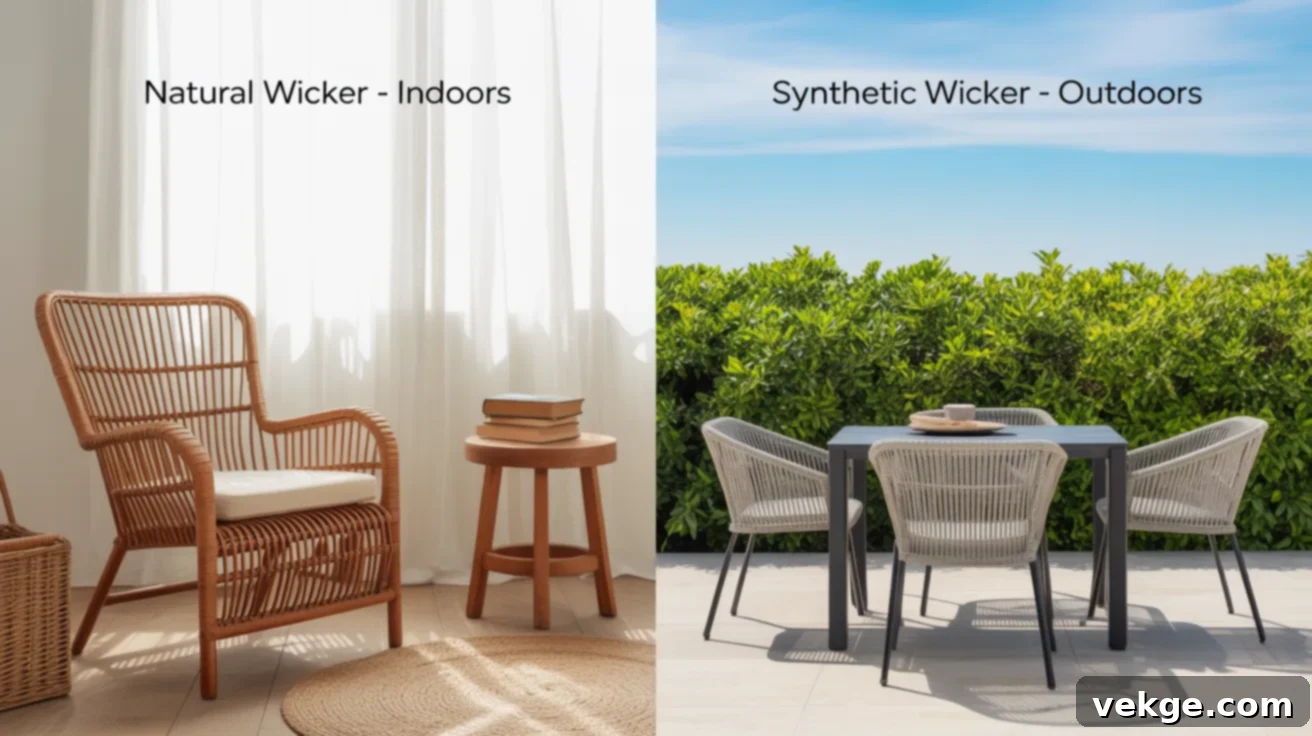
The distinction between natural and synthetic wicker is paramount when considering its interaction with water. Each type offers different properties, demanding specific care and suitability for various environments. Understanding these differences is the first step toward effective protection.
Natural wicker is crafted from organic plant fibers such as rattan, bamboo, willow, reed, and even certain grasses. These materials are beautiful, offering a warm, earthy texture and a classic, natural aesthetic. However, their organic nature makes them highly susceptible to moisture damage. They absorb water, which can lead to a host of problems if not properly managed. Natural wicker is best suited for indoor environments or well-covered outdoor spaces where it is protected from direct exposure to elements.
Synthetic wicker, often referred to as “resin wicker” or “all-weather wicker,” is made from man-made materials, primarily polyethylene (HDPE) resin. This type of wicker is engineered specifically for outdoor use, designed to withstand a range of weather conditions far better than its natural counterpart. It mimics the look and feel of natural wicker but boasts superior resistance to moisture, UV rays, and temperature fluctuations, making it ideal for patios, gardens, and poolside areas.
Here’s a quick table to help you compare natural and synthetic wicker, highlighting their main differences in a simple way:
| Feature | Natural Wicker | Synthetic Wicker |
|---|---|---|
| Material Source | Real plant materials (e.g., rattan, bamboo, willow) | Man-made (typically polyethylene resin, plastic) |
| Look and Feel | Warm, earthy, unique natural texture, often develops a patina over time | Similar aesthetic, but smoother, more uniform, and available in a wider range of colors |
| Durability Outdoors | Poor — highly prone to rotting, fading, cracking, and structural breakdown in rain or sun | Excellent — specifically designed to resist weather, moisture, UV rays, and temperature changes |
| Maintenance | Requires more diligent care: keep dry, clean gently, may need sealing | Low maintenance: easy to clean, generally does not require sealing, simply wipe down |
| Best Use | Indoors, sunrooms, or fully covered outdoor spaces (e.g., screened porches) | Patios, gardens, poolside areas, balconies, or any exposed outdoor setting |
| Cost | Usually higher due to the processing of natural, often hand-harvested materials | Often more budget-friendly and widely available, offering good value for outdoor use |
| Eco-Friendliness | Biodegradable and sourced from renewable resources (if harvested sustainably) | Not biodegradable, but its extended lifespan reduces the frequency of replacement |
Can Wicker Furniture Get Wet? The Definitive Answer
Yes, wicker furniture can get wet, but the critical factor determining whether it’s “okay” or harmful depends entirely on whether it’s natural or synthetic. This distinction dictates the level of resilience and the necessary preventative measures.
Natural Wicker and Water: A Risky Combination
Natural wicker, crafted from organic plant fibers like rattan, bamboo, or willow, is highly porous. These materials readily absorb water, much like a sponge. When natural wicker gets wet, several detrimental processes begin:
- Softening and Weakening: Water causes the plant fibers to swell and soften, making the furniture structurally weak and pliable. This can lead to sagging, distortion, and loss of original shape.
- Mold and Mildew Growth: If natural wicker remains damp for an extended period, it becomes a perfect breeding ground for mold and mildew. These fungi not only produce an unpleasant odor and unsightly black or green spots but also actively degrade the fibers, leading to rotting and decay.
- Cracking and Brittleness: The repeated cycle of getting wet and then drying out can cause the fibers to expand and contract. Over time, this stress leads to cracking, splitting, and brittleness, ultimately causing the furniture to fall apart.
- Discoloration and Stains: Water, especially if it contains impurities, can leave unsightly stains and cause the natural color of the wicker to fade or darken unevenly.
For these reasons, natural wicker should ideally be kept indoors or in fully covered outdoor areas that offer complete protection from rain, snow, and persistent humidity.
Synthetic Wicker and Water: Built for the Outdoors
Synthetic wicker, primarily made from polyethylene (HDPE) resin, is designed with outdoor resilience in mind. Its non-porous nature means it does not absorb water in the same way natural fibers do. This makes it significantly more resistant to moisture, mold, mildew, and rot.
However, even synthetic wicker isn’t entirely “waterproof” in the absolute sense:
- Surface Mold: While the material itself resists mold, dirt, pollen, and other organic matter can accumulate on its surface. If these residues remain wet for too long, particularly in humid conditions, surface mold can still develop. This is usually easy to clean but requires attention.
- UV Degradation: Prolonged exposure to sun and water, combined with fluctuating temperatures, can eventually cause synthetic wicker to fade, become brittle, or even crack over many years. High-quality synthetic wicker usually includes UV inhibitors to slow this process.
- Rust on Metal Frames: Often, synthetic wicker is woven over an aluminum or steel frame. While aluminum frames are rust-resistant, steel frames (if not properly treated) can rust when exposed to moisture, potentially staining the wicker or compromising the furniture’s structural integrity.
In summary, synthetic wicker handles moisture exceptionally well and is suitable for outdoor use. However, even it benefits from occasional protection and regular cleaning to maintain its appearance and longevity.
The Damaging Effects of Weather on Wicker Furniture
Understanding how different weather elements specifically impact wicker furniture is crucial for effective protection. Each type of precipitation and atmospheric condition presents unique challenges, particularly for natural wicker.
Rain: The Most Common Threat
Rain is arguably the most common and immediate threat to natural wicker. As plant fibers, natural wicker acts like a sponge, quickly soaking up rainwater. This saturation leads to rapid softening and weakening of the woven strands, making the furniture prone to bending, sagging, and losing its intended shape. If left to air dry slowly, especially in shady or poorly ventilated areas, the persistent dampness creates an ideal environment for mold and mildew to flourish, causing discoloration, unpleasant odors, and structural decay. Repeated exposure to rain can also strip away any protective finishes, accelerating the breakdown of fibers and leading to cracks and brittleness.
For synthetic wicker, direct rain is less of a concern for the material itself, as it’s non-porous. However, rainwater can still carry dirt, pollen, and other organic debris onto the surface, which, if left to sit, can lead to surface mold. Additionally, if the furniture cushions are not removed, they will absorb water, becoming heavy, uncomfortable, and susceptible to mildew.
Snow and Ice: A Prolonged and Damaging Chill
Snow and ice pose an even greater threat than rain, primarily due to prolonged moisture exposure and temperature extremes. When snow accumulates on wicker furniture, it melts slowly, keeping the material wet for extended periods, sometimes days or weeks. This extended dampness allows moisture to penetrate deeply into natural wicker fibers, significantly increasing the risk of severe mold, rot, and structural failure.
Furthermore, the freezing and thawing cycles associated with snow and ice can be incredibly destructive. As water freezes within natural fibers, it expands, putting immense pressure on the cellular structure. This repeated expansion and contraction can cause the fibers to crack, splinter, and become incredibly brittle, weakening the entire piece of furniture. Even for synthetic wicker, while less susceptible to direct water damage, extreme cold can make the resin more brittle and prone to cracking if bumped or moved, particularly if the material is of lower quality or has been degraded by UV exposure over time.
Humidity: The Silent Destroyer
Humidity, often overlooked, is a silent and insidious destroyer of natural wicker. Unlike direct rain or snow, humidity introduces moisture into the air, which is then slowly absorbed by the porous plant fibers over time. This gradual, persistent absorption can lead to a range of issues that may not be immediately apparent but build up over weeks and months.
In highly humid environments, natural wicker can continually absorb moisture, leading to persistent softness, warping, and bending. This constant state of dampness promotes the growth of mold and mildew, even without direct rain exposure. Conversely, if humidity fluctuates drastically, the wicker will repeatedly absorb and release moisture, causing expansion and contraction that can result in tiny cracks, peeling finishes, and overall structural weakening. Even in enclosed spaces, such as storage sheds or sunrooms with poor ventilation, high humidity can cause problems for natural wicker.
Synthetic wicker is largely unaffected by humidity, though prolonged exposure to a humid atmosphere can contribute to the growth of surface mold if the furniture is not cleaned regularly.
Why Climate Matters for Wicker Furniture Care
The local climate plays a significant role in determining the ideal care and placement of your wicker furniture. What works in a dry, arid region might be disastrous in a perpetually damp one.
- Wet and Humid Regions: In areas with frequent rainfall, high humidity, or coastal proximity, natural wicker should almost exclusively be kept indoors or within fully enclosed, well-ventilated spaces. Even synthetic wicker benefits from protective covers during heavy downpours or extended periods of non-use to prevent surface grime and keep cushions dry. Regular cleaning is paramount to combat mold and mildew.
- Dry and Arid Regions: While moisture isn’t a primary concern, intense sunlight and low humidity can cause other problems. Constant UV exposure can dry out natural wicker, making it brittle and prone to cracking, while also fading its color. Synthetic wicker, even with UV inhibitors, can degrade over time. Providing shade, using UV-protective covers, and occasionally conditioning natural wicker can mitigate these risks.
- Four-Season Climates: In regions experiencing distinct seasons, flexible protection strategies are essential. Wicker furniture that is used outdoors will require seasonal adjustments, including diligent covering during rainy periods, quick drying after any moisture exposure, and comprehensive winterization strategies when temperatures drop below freezing.
Essential Strategies to Protect Wicker Furniture from Water Damage
Protecting your wicker furniture from water damage is a proactive measure that ensures its longevity and aesthetic appeal. The good news is that with a few simple steps, you can significantly extend the life of both natural and synthetic wicker.
Preventive Measures for All Wicker Types
These actions are universal and highly effective in safeguarding your wicker investment:
- Use High-Quality Furniture Covers: Investing in waterproof and breathable furniture covers is one of the easiest and most effective ways to protect your wicker. Ensure the cover fits snugly, but allows for some air circulation to prevent moisture buildup underneath. Use them whenever rain is forecast, or during extended periods of non-use.
- Choose Sheltered Locations: Whenever possible, place your wicker furniture under a covered patio, gazebo, awning, or porch. This provides an immediate barrier against direct rain and harsh sunlight.
- Elevate Furniture Legs: If your furniture sits directly on the ground, especially on a patio that collects water, consider placing small, non-absorbent risers or furniture feet under the legs. This prevents water from pooling around the base and soaking into the material.
- Store Cushions Indoors: Cushions are highly absorbent and a prime target for mold and mildew. Always bring cushions indoors when not in use, especially overnight or during inclement weather. Consider investing in outdoor cushion storage boxes that are waterproof.
- Regular Cleaning: Keep your wicker clean. Dust, dirt, and organic debris can trap moisture and act as a food source for mold and mildew. Regular cleaning prevents these issues from escalating.
Waterproofing Natural Wicker: The Easy Way
While synthetic wicker is inherently water-resistant, natural wicker can greatly benefit from a waterproofing treatment. This process creates a protective barrier, making the fibers less absorbent and more resilient to occasional moisture exposure. Remember, this is not a permanent solution for leaving natural wicker exposed to constant rain, but it offers significant protection.
Here’s a quick guide to do it right:
Step 1: Clean the Surface Thoroughly
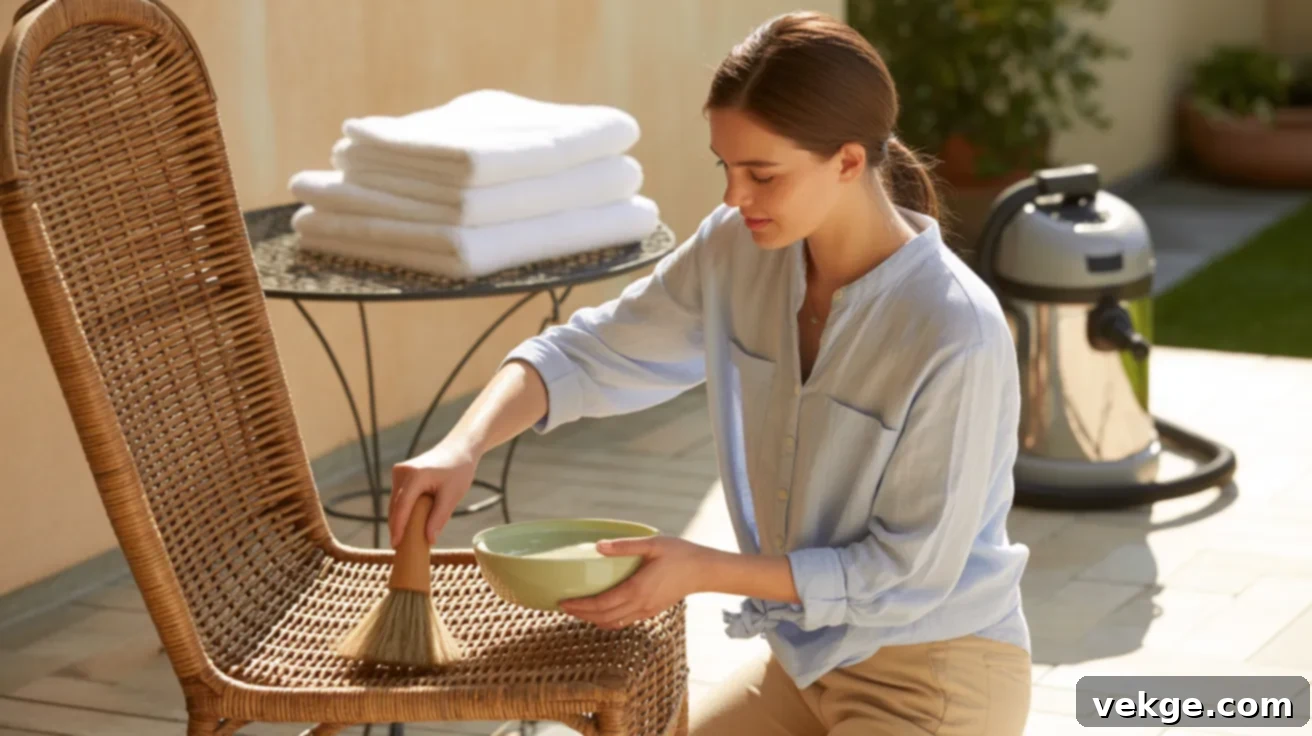
Begin by ensuring your wicker furniture is spotless. Use a soft-bristled brush or a vacuum cleaner with a brush attachment to remove all dust, dirt, and debris from the weaves. If the furniture is particularly grimy, gently wash it with a solution of mild soap (like dish soap) and warm water, using a soft cloth or sponge. Avoid saturating the wicker. Rinse lightly and allow the furniture to dry completely for at least 24-48 hours in a well-ventilated area before proceeding to the next step. Any trapped moisture will compromise the sealant’s effectiveness.
Step 2: Lightly Sand for Better Adhesion (Natural Wicker Only)
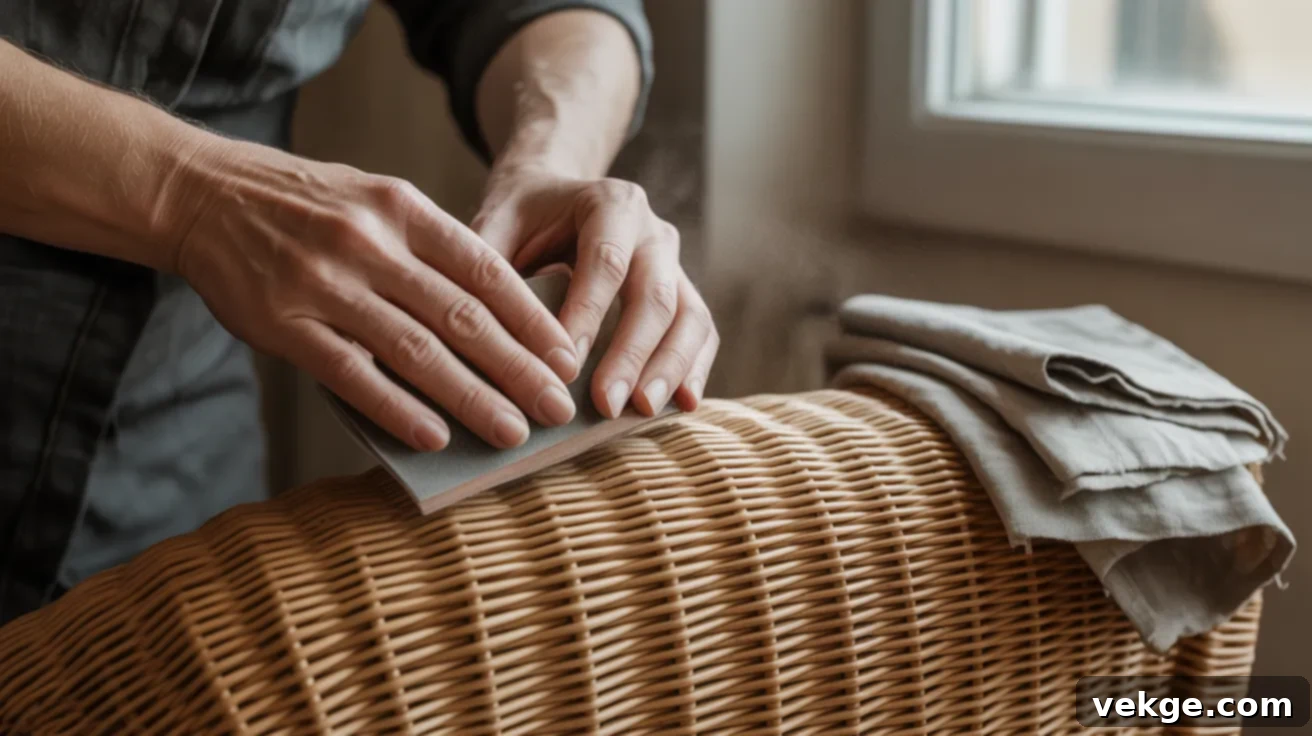
This step is crucial for natural wicker as it helps the sealant adhere better to the surface. Using fine to medium-grit sandpaper (around 150-220 grit), lightly sand the entire surface of the wicker. This will rough up the fibers slightly, creating a better “grip” for the waterproofing agent. Pay attention to all sides of the woven strands. After sanding, meticulously wipe away all sanding dust with a tack cloth or a slightly damp cloth, ensuring the surface is perfectly clean and smooth before applying the sealant.
Step 3: Apply a Quality Waterproof Sealant
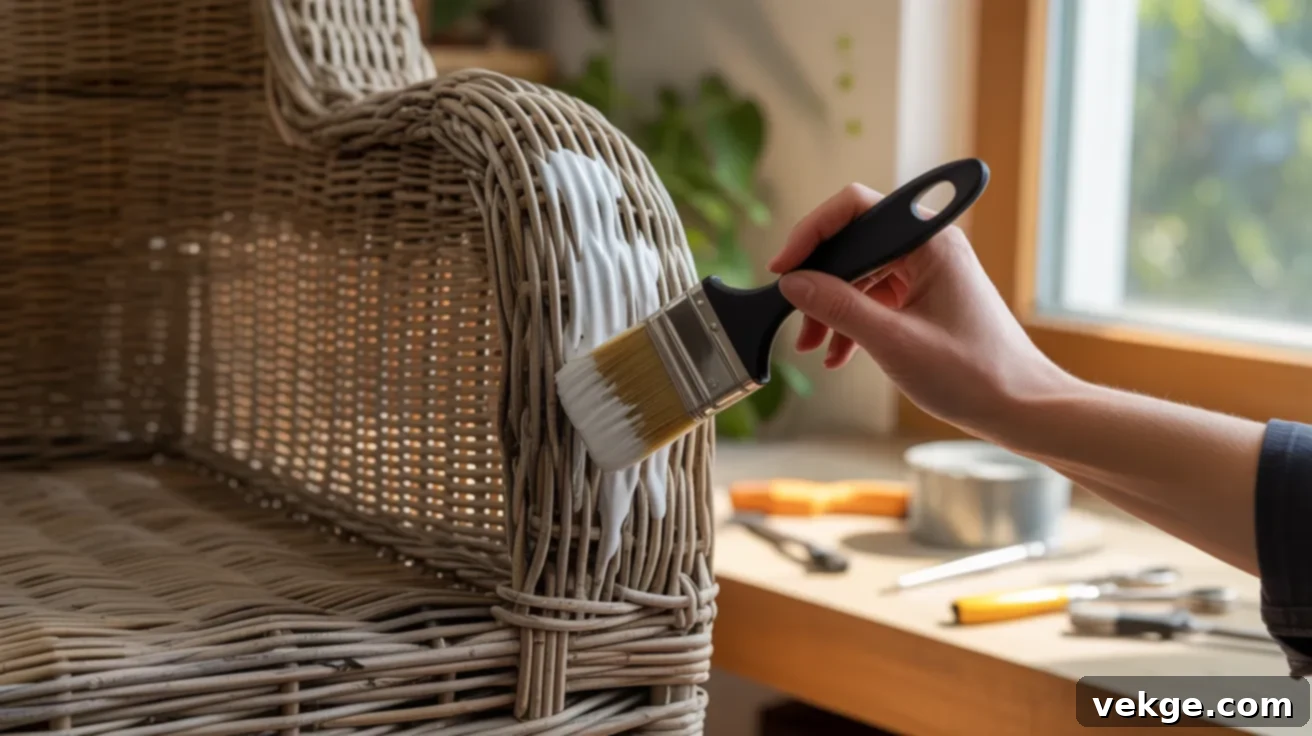
Choose a clear, outdoor-grade waterproof sealant such as marine varnish, spar urethane, or a polyurethane specifically designed for exterior use. These products offer excellent protection against moisture and UV rays. Apply the sealant with a brush or foam applicator, ensuring even coverage over all surfaces. Work in small sections, making sure to coat all the intricate weaves, cracks, and corners. For optimal protection, apply 2-3 thin coats, allowing each coat to dry completely according to the manufacturer’s instructions before applying the next. Avoid applying too thickly, as this can lead to drips and uneven drying.
Step 4: Allow for Complete Drying and Curing
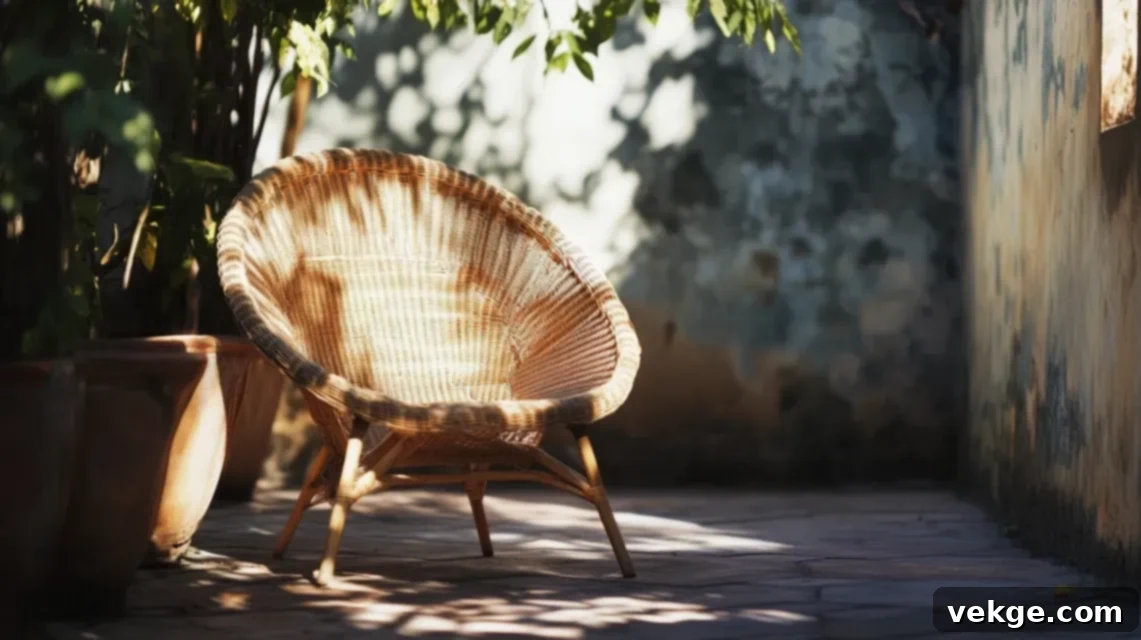
After applying the final coat, place the furniture in a dry, well-ventilated area, away from direct sunlight or extreme temperatures. Allow it to dry and cure fully as per the product label – this can take anywhere from 24 hours to several days. The curing process is essential for the sealant to achieve its maximum hardness and protective qualities. Resist the urge to use the furniture or expose it to moisture until it’s completely cured. Reapply sealant every 1-2 years, depending on exposure and wear, to maintain optimal protection.
How to Dry Wicker Quickly and Safely After Getting Wet
If your wicker furniture does get wet, especially natural wicker, prompt and thorough drying is critical to prevent damage. Here’s how to do it safely and effectively:
- Immediate Wipe Down: As soon as you notice the wicker is wet, use clean, dry towels or rags to wipe off as much surface water as possible. Blot, don’t rub, to avoid damaging the fibers.
- Maximize Airflow and Sunlight: Move the wet furniture to a sunny, breezy spot. Sunlight helps to evaporate moisture, and good airflow speeds up the drying process. Rotate the furniture periodically to ensure all sides get exposure.
- Utilize Fans (Indoors): If outdoor conditions aren’t ideal (e.g., cloudy, humid), bring the furniture indoors and place it near a fan or dehumidifier. Ensure the room is well-ventilated.
- Invert or Elevate: Turn the furniture over or prop it up to allow air to circulate underneath and prevent water from pooling in hidden crevices. This is particularly important for chairs or tables with flat bases.
- Remove Cushions and Accessories: Always remove any cushions, pillows, or decorative items, as they will hold moisture and impede the drying process of the wicker itself. Dry cushions separately.
- Avoid Direct, High Heat: Do NOT use a hairdryer, heat gun, or direct strong heaters to dry wicker. Excessive, concentrated heat can cause natural wicker fibers to become brittle, crack, warp, or even shrink. For synthetic wicker, it can cause melting or distortion. Gentle, ambient drying is always preferred.
- Ensure Complete Dryness: Before returning the furniture to its usual spot or putting cushions back, make absolutely certain it is completely dry to the touch, inside and out. Any residual dampness, especially in natural wicker, will quickly lead to mold and mildew.
Year-Round Maintenance Tips for Wicker Furniture Longevity
Consistent care is the secret to keeping your wicker furniture looking pristine and extending its life significantly. These maintenance tips are designed to address the specific needs of wicker throughout the seasons.
- Regular Dusting and Cleaning:
- Weekly: Use a soft brush, a feather duster, or a vacuum cleaner with a brush attachment to remove dust, cobwebs, and loose debris from the weaves. This prevents dirt from becoming embedded.
- Monthly/Quarterly (or as needed): For a deeper clean, mix a small amount of mild dish soap with warm water. Dampen a soft cloth or sponge with the solution and gently wipe down the wicker. For natural wicker, ensure the cloth is only damp, not soaking wet, and dry immediately. For synthetic wicker, you can be a bit more generous, but always rinse thoroughly with clean water and dry completely.
- For stubborn dirt or mildew on synthetic wicker: A solution of equal parts white vinegar and water, or a gentle bleach solution (1 part bleach to 10 parts water), can be used. Test in an inconspicuous area first. Rinse well and dry.
- Seasonal Inspections and Care:
- Spring Refresh: As warmer weather approaches, give your outdoor wicker a thorough cleaning. Inspect for any signs of winter damage, such as loose weaves, cracks, or mold. Address any issues promptly.
- Summer Protection: During peak usage, keep wicker shaded from intense direct sunlight to prevent fading and material degradation (especially for synthetic wicker’s lifespan). Wipe off any spills or rain quickly. Bring cushions in nightly.
- Fall Preparation: As temperatures drop and rainfall increases, begin preparing for winter. Clean furniture thoroughly before covering or storing. Check for any minor repairs needed.
- Addressing Damage and Knowing When to Replace:
- Mold or Mildew: For minor surface mold on synthetic wicker, a bleach/water solution can work. For natural wicker, cleaning is much harder, and extensive mold might mean replacement to prevent health hazards and further decay.
- Cracks or Loose Weaves (Natural Wicker): Small cracks or loose strands can sometimes be glued back into place with strong wood glue. However, widespread cracking or structural sagging indicates irreversible damage due to moisture or age, and replacement is likely necessary.
- Fading or Peeling Finish: For natural wicker, this means the protective sealant has worn off and needs reapplication. For synthetic wicker, significant fading or brittleness indicates the UV stabilizers have degraded, and the material’s lifespan is nearing its end.
Winter Storage Tips for Wicker Furniture
Winter can be particularly harsh on outdoor furniture, especially wicker. Proper storage is crucial to prevent cold, moisture, and potential freezing damage. These steps will help your wicker furniture emerge from winter as good as new.
- Bring it Indoors or to a Covered Area: The absolute best way to protect wicker during winter is to store it indoors. A garage, shed, basement, or even a spare room provides ideal protection from the elements. If indoor storage isn’t an option, move it to a completely covered patio or porch that offers significant shelter from rain, snow, and wind.
- Clean and Dry Thoroughly: Before storing, give your wicker a complete cleaning as described in the maintenance section. Crucially, ensure it is bone-dry before putting it away. Even a small amount of residual moisture can lead to mold, mildew, or rot during storage.
- Keep it Dry During Storage: Choose a storage location that is dry and relatively free from humidity. Avoid damp basements or sheds that are prone to leaks. If storing in a garage or shed that can get damp, consider placing a dehumidifier nearby or using moisture absorbers.
- Use Breathable, Waterproof Covers: If indoor storage isn’t possible, and your furniture is in a covered outdoor area, use high-quality, breathable, waterproof covers. Breathable covers are vital to prevent moisture buildup and condensation, which can still lead to mold even under a cover. Avoid cheap plastic tarps that trap humidity.
- Lift it Up: If storing on a concrete or dirt floor, place the furniture on wooden pallets, blocks, or furniture risers. This elevates the legs off the ground, preventing moisture wicking up into the material and protecting it from any potential flooding or condensation.
- Store Cushions Separately and Indoors: Cushions are highly susceptible to mildew. Always remove all cushions and store them in a dry, climate-controlled indoor environment, such as a closet or plastic storage bins. Ensure they are completely dry before storage.
- Avoid Airtight Plastic Wrap: While it might seem like a good idea to completely seal furniture in plastic wrap, this can trap moisture and create a perfect environment for mold and mildew. Breathable covers are a much better choice.
- Check Periodically: Even in storage, it’s a good idea to check on your wicker furniture a few times throughout the winter, especially if it’s stored in a non-climate-controlled area. Look for any signs of dampness, mold, or pest activity.
- Label Parts for Easy Reassembly: If you need to disassemble your furniture for storage, label all parts, screws, and hardware. Store them in a clearly marked bag attached to the furniture for easy reassembly in the spring.
- Prep Early: Don’t wait until the first snow or freezing rain. Begin your winterization process in early fall, after the peak outdoor season, to ensure everything is clean, dry, and safely stored before the harsh weather arrives.
Frequently Asked Questions About Wicker Furniture and Water
Here are some common questions people ask about wicker furniture and how it interacts with water:
Can I leave synthetic wicker out in the rain?
Yes, high-quality synthetic (resin) wicker is designed for outdoor use and can withstand rain without sustaining significant damage. However, it’s still advisable to cover it during prolonged heavy downpours or when not in use for extended periods to prevent surface grime buildup and extend its lifespan. Always remove cushions, as they are usually not waterproof.
How do I remove mold or mildew from wicker?
For synthetic wicker, mix equal parts white vinegar and water, or a mild bleach solution (1 part bleach to 10 parts water). Apply with a soft brush, scrub gently, let sit for a few minutes, then rinse thoroughly and dry completely. For natural wicker, mold is more problematic. Try a gentle scrub with mild soap and water, followed by a vinegar solution. If mold has deeply set in, it might be difficult to remove completely without damaging the fibers, and professional cleaning or replacement might be necessary.
What’s the best sealant for natural wicker?
Marine varnish or spar urethane are excellent choices for sealing natural wicker. They are designed for outdoor use and provide good protection against moisture and UV rays. Ensure the product is clear and specifically labeled for exterior application. You should reapply it every 1-2 years depending on exposure.
Is rattan the same as wicker?
No, rattan is a material, while wicker is a weaving method. Rattan is a type of vine-like palm that grows in tropical regions, and it’s one of the most popular natural materials used to create wicker furniture. So, wicker furniture can be made *from* rattan, but not all wicker is rattan, and not all rattan is woven into wicker.
How often should I clean my outdoor wicker furniture?
For synthetic wicker used outdoors, a light dusting or quick wipe-down weekly or bi-weekly is good practice. A deeper wash with soap and water should be done monthly or quarterly, or as needed, especially after heavy rains or pollen seasons. Natural wicker kept indoors needs regular dusting and occasional gentle wiping, avoiding excessive moisture.
Wrapping Up
The question, “Can wicker furniture get wet?” now has a comprehensive answer: it depends on the type, and its reaction dictates the care it needs. Natural wicker, with its porous organic fibers, is highly vulnerable to water, risking mold, rot, warping, and structural decay. Synthetic wicker, crafted from resilient polyethylene resin, is designed to withstand outdoor elements, making it a far more robust choice for areas exposed to moisture.
This guide has equipped you with everything you need to know, from understanding the fundamental differences between wicker types to applying effective waterproofing techniques, drying wet furniture safely, and implementing year-round maintenance strategies. By embracing these expert tips, you can significantly extend the life and preserve the beauty of your wicker furniture, ensuring it remains a cherished part of your home or outdoor oasis for many seasons to come. Don’t leave your furniture unprotected; take action today to safeguard your investment.
Have more questions or need personalized advice on choosing the right products for your wicker furniture? Feel free to reach out, or explore our other detailed guides to stay one step ahead in furniture care.
